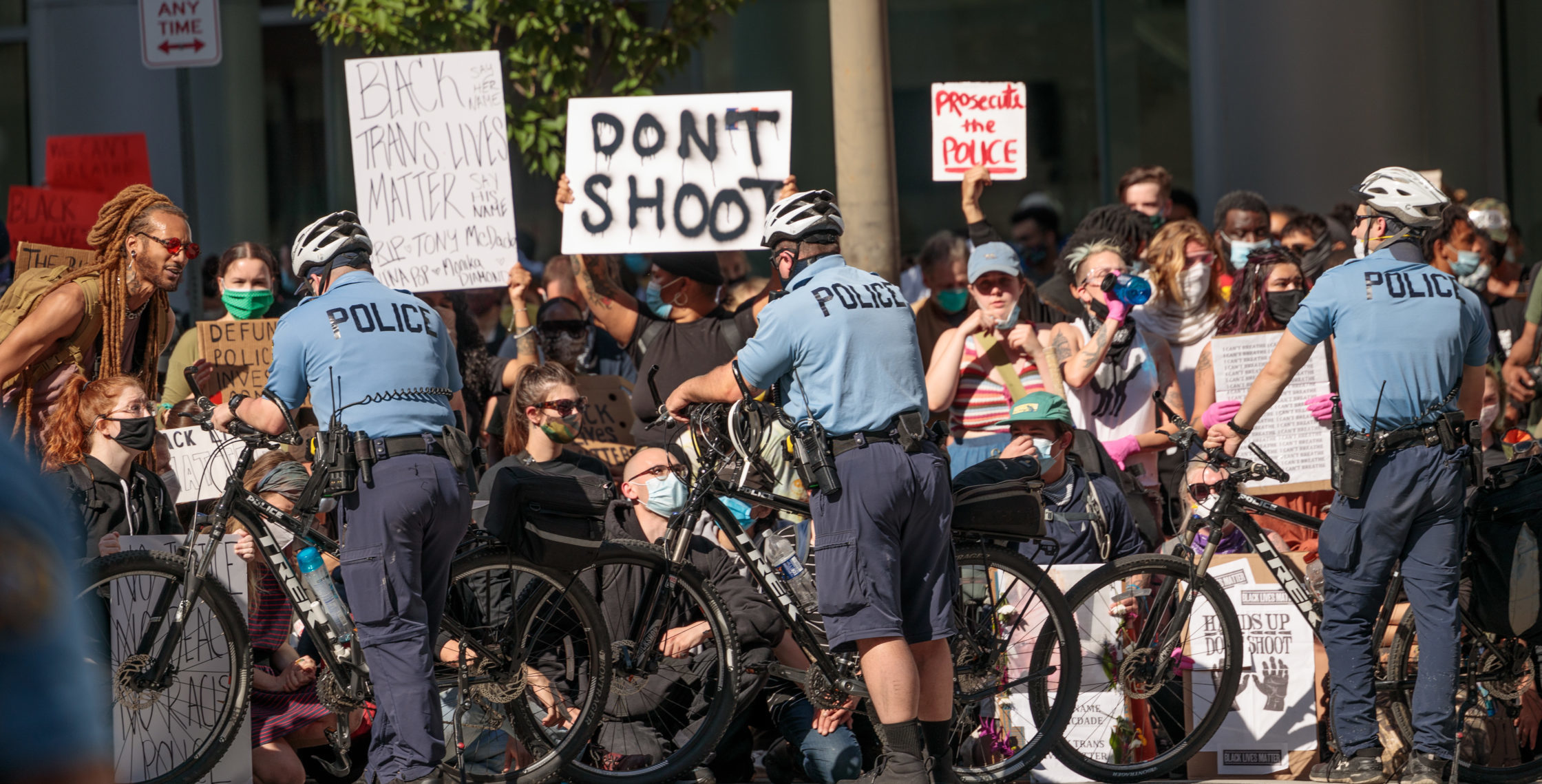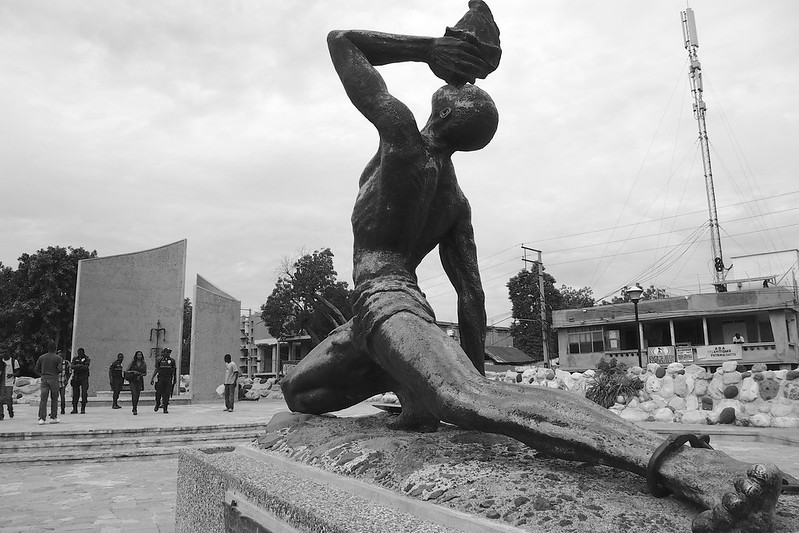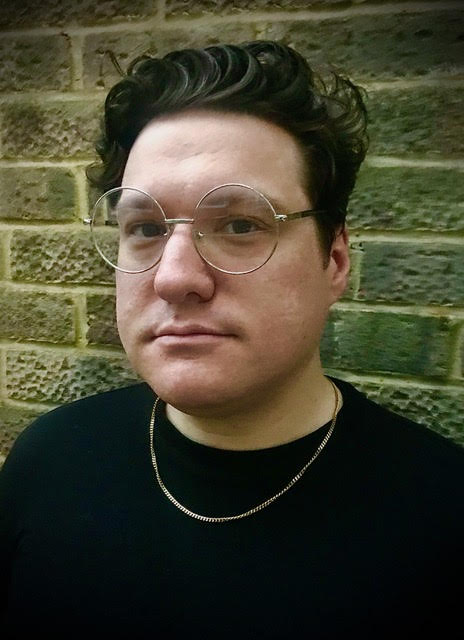
I saw something strange on June 1st, 2020. I saw the work of a generic theodicy take place on live television. I had come to the UK for a visit during my university’s spring break, only to find the majority of transatlantic flights cancelled and lockdowns imposed within the next few days. This meant that my stay had been extended indefinitely. So when the uprisings in protest against the continued police violence and murder of Black men and women began across cities in the United States, I could only watch my social media timelines anxiously as the police response in my home city of Philadelphia turned ever more violent. On June 1st I found a livestream of some mainstream local news covering one of the largest peaceful protest marches Philadelphia has ever seen. I was surprised to listen to the news anchors speak positively and compassionately about the protests. As the anchors were talking a large section of the protest did something other marches have tried to do in the past. They took I-676, a bit of the interstate that runs through Philadelphia’s Center City, stopping traffic and marching on the highway itself. The anchors seemed surprised but again remarked at how peaceful the protest had been and cut to a short story by a reporter on the ground about the peaceful events of the day so far. When they cut back to the live scene suddenly there was pandemonium as tear gas—a chemical that is banned in war by the Geneva Convention—enveloped I-676, wafting over the peaceful protesters and even the cars that had been caught in the protest march. Police in SWAT gear and with automatic rifles began to swarm the protesters. There is video of these police indiscriminately pepper spraying protesters who have their hands up and people rushing in panic to try get off the highway by climbing over concrete embankments and fences as police damage protester’s bikes and line up zip-tied protestors in stress positions on the hot and dirty highway.
The anchors immediately began to look for a reason why this was happening. They could not figure out why the police would be so violent in the face of non-violent protesters. The obvious answer is that the police are a violent force and should be abolished. To accept that would be to call into question the entire world that police violence supports, to see in the incoherence of the violence against non-violent protests the same incoherence of struggle and suffering that undoes the world, that undoes our very sense of selves. In searching for a justification for this unjustifiable violence of the police, the anchors were engaged in theodicy.
What is Theodicy?
Theodicy is both a concept and a discourse that comes to us today from the traditions of Christian theology and European philosophy. Traditionally the term refers to the justification of the existence of a benevolent God in the face of the problem of evil or suffering and broken into its Greek roots theos (God) and dike (justice) it literally means the justification of God. However, what we will see in this short essay, working with Sylvia Wynter’s treatment of theodicy as a technology, is a much more generic form of theodicy. In that generic form, theodicy is a matter of asserting coherence when confronted with the incoherence of struggle and suffering. This generic understanding of theodicy becomes apparent when we start to examine it as a particular technology connected to the project of European colonialism, with that project’s twinned history of settler-colonialism throughout the Americas and enslavement of Black Africans. Subjecting theodicy to this kind of examination is what Dipesh Chakrabarty refers to as “provincializing.” By provincializing theodicy, a central concept within philosophy of religion, we can begin to open up our thinking to the incoherence of suffering and struggle and begin to construct a thought worthy of what cannot be justified.
White Thought, Annotated and Exposed
One of the gifts that comes from engaging with decolonial theory is this provincialization of philosophy as white thought. Reactionary intellectuals often accuse decolonial theorists of being smugly satisfied in pronouncing some moral judgment over this or that particular philosopher. While we may find moral judgments like “Kant’s a racist!” or “Hegel’s a misogynist!” being thrown around a seminar table or turned into a meme to be scrolled past on social media, any such moral judgment is already superfluous for decolonial engagements with European philosophy. The risible and horrific statements of the pantheon of European philosophers regarding women, Africans, Jews, Muslims, and others outside a narrowly constructed identity of European whiteness are already well documented and in fact can be “revealed” simply by reading their most famous texts. There is no need for some hermetic method; it is shamelessly right there on the page. The task of reading the history of European philosophy from a decolonial perspective does not need to be one concerned with the place of the individual philosopher or theorists within history, but can concern itself directly with a kind of cartography of the world as constructed and reflected in that thought. This method says, here is the world as made by White Europeans, here are the paths you are told to follow, here are the divisions between this and that, the “civilized” and the colonized, “free” and slave. This is the world you have to navigate and such a map may be useful when it marks out the positions where philosophy is policed and where philosophers are the police. With such a map you may be able to avoid or evade them.
While we may find moral judgments like “Kant’s a racist!” or “Hegel’s a misogynist!” being thrown around a seminar table or turned into a meme to be scrolled past on social media, any such moral judgment is already superfluous for decolonial engagements with European philosophy.
Christina Sharpe builds a theoretical architecture of “Black life, annotated and redacted” for Black scholars engaged in Black studies for Black people. White scholars can place themselves under the demands of Black study without appropriating or profiting from this Black life by following the example of Sharpe’s method, but now directed at this newly provincialized white thought. Let us consider this cartographical method of study to be “white thought, annotated and exposed.” Annotating white thought in this way can be a strategy to be used against it, to evade it, to describe it ruthlessly and rigorously, and add to efforts to abolish it in its actualities and possibilities. Most assuredly this is not to critique it, which is how white thought continues as white thought, but it is rather to move away from it or to break it down into parts which might be useful when disempowered from the whole of the machinery. Daniel Colucciello Barber provides an example of this kind of annotated white thought that takes aim at the role of critique in continuing the world. When used in this way, annotations are a form of negation even as they are additions to the text. The annotations are made to mark out and better avoid philosophy’s checkpoints, the places where one is harassed and where demands for one’s papers are made. It is to mark the places where philosophy is part of an apparatus that decides one’s status, both as a political being and as a being. In other words, it shows how philosophy is part of the apparatus that determines what side of the border one is placed, whether that border be internal or external.
Sylvia Wynter on Theodicy
Theodicy should be subject to this annotation and requires such a cartography, for it manifests a general form of European thought—inclusive of the violent colonizing brothers, philosophy and theology—that plays a particular role within the construction of the colonial world. Sylvia Wynter has begun to trace such a category in her work. She has demonstrated that the appeal to theodical forms of thought is present throughout attempts to think about the history of racial-colonial capitalism. Wynter directs our attention here when she emphasizes the words of an apologist for colonialism, Gregory Cerio, who attempts to “deconstruct” the “black legend” of Spanish atrocities against the indigenous peoples of the so-called “New World.” Cerio provides a culturally relativistic defense of the Spanish saying that, by their standards, they acted with moderation and even “accepted” the indigenous into Spanish society. Wynter emphasizes the theodical nature of his claim by italicizing his assertion that the Spanish “sought to provide a philosophical and moral foundation for their actions in the New World” (6).
Theodicy, as a general form of philosophical thought, is the theoretical justification of any system or relationship generative of meaning that places the violence and suffering necessary for that system’s operation within a narrative of redemption.
To provide a foundation is to provide a justification. This task of justification is not foreign to forms of philosophy taken to be central to the history of European thought. Hegel, for example, famously remarked in his Lectures on the Philosophy of History that his philosophy of history was a theodicy, an attempt to reconcile all the suffering and evils of the world with the accomplished aims of reason. He writes, “That world history is governed by an ultimate design, that it is a rational process—whose rationality is not that of a particular subject, but a divine and absolute reason—this is a proposition whose truth we must assume; its proof lies in the study of world history itself, which is the image and enactment of reason” (28). Stated with less theodical disavowal, all the “bad things” about the world, like the horrific violence and suffering of colonization and slavery, are justified by the goodness of the world’s ultimate reason.

Wynter’s patient elaboration and re-elaboration of the racial-colonial and capitalist development of what it means to be human emerges necessarily in relation to these theodical philosophical and moral justifications, not simply as an intellectual problem but a social one. Denise Ferreira da Silva tells us that Wynter’s work is faithful to the early tenants of historical materialism. Wynter’s examination of the concept of race does not reduce it to some ideological excuse for colonialism, but the concept is itself made possible and emerges only on the basis of the social relation of “colonizer/colonized” (92). In other words, theodicy is called forth not by pure reason, but through our living as social beings and by a particular way of organizing that living together. With regard to the racial classification of people, theodicy is called forth by the need to justify why this person should suffer in absolute terms so that this person may live a good life. The incoherence of the forced living together of the colonizer and the colonized, and the even more extreme and incoherent violence of the relationship between slaver and enslaved, must be made sense of. Theodicy, as a general form of philosophical thought, is the theoretical justification of any system or relationship generative of meaning that places the violence and suffering necessary for that system’s operation within a narrative of redemption.
We can see this more clearly in Wynter where theodicy is especially related to the colonial episteme. In this colonial episteme, the creation of coherent sense or meaning is required to support the dominant genre of the human. The existence of any genre of the human, be it Christian, Man1, or Man2 (these being the three genres examined in Wynter’s work), must be justified in the face of suffering and evil that threatens the coherence and meaning of the human. For it is the genre of the human that, Wynter says, “aprioristically underlies all our present disciplines” (117). What it means to be human, the question of who “we” are, is produced through these genres of being “in whose,” Wynter says, “always auto-instituted and origin-narratively inscribed terms we can alone experience ourselves as human” (117). Theodicy arises out of the desire that we have the rules of order, the theoretical grammar, to experience ourselves, in so far as we are constituted relationally as social beings.
Following Wynter, provincializing theodicy allows us to name theodicy as a concept or technology and not a problem. Here Wynter follows Lewis Gordon who identifies a secular form of theodicy in biological frameworks for understanding the human. He names this a “biodicy” that serves to justify the pain and suffering experienced within the here and now by appealing to a source of legitimacy. Wynter says that one can generalize from Gordon’s concept of a secular theodicy to all “supernaturally legitimated and guaranteed human societal orders” (137). This leads to a general statement of the form of theodicy:
“Doing this by extending the traditional meaning of theodicy—that is, as an order that functions to justify the ways of God to mankind—to one in which all supernaturally guaranteed orders must function in a cognitively closed manner, in order to justify the order and its everyday function, to its subjects, as the realization of a true, because ostensibly supernaturally mandated, order” (135).
The need for some form of theodicy arises from one genre of the human being taken as the absolute identity—meaning absolute self-sameness—of the human as such. Wynter demonstrates that as the genre shifts so must the underlying source of legitimacy. Theodicy does not disappear but is replaced by whatever is taken to be the supreme Being or supreme source of legitimacy. Theodicy then lies at the level of meaning itself.
After Theodicy
Earlier, I noted that Wynter treats theodicy as a technology and not a problem. This is distinctive and incisive because inside of the history of philosophy of religion and philosophical theology theodicy was understood as an intellectual problem relating to the external and objective reality of God. When philosophers of religion accept this story they are only able to see arguments for God’s benevolence in the face of the problem of evil and suffering. What they miss and Wynter sees is that the name of God hides a more generic problem of coherence and meaning that is implied in the function of God for those historical systems of thought and practice. As Wynter has shown, the project of theodicy does not historically or abstractly require the theistic figure of God as given shape by certain theoretical interpretations and communal beliefs found within Christianity or any other particular monotheistic tradition. The form of this thinking persists even in seemingly secular times.
Perhaps the most egregious element of theodicy is the central practice of analogizing between times and peoples, between their sufferings and the specific role their relations plays in the creation of the world. Only by obscuring the particularity of suffering through what Frank B. Wilderson III identifies as the universalizing ruse of analogy does theodicy redeem the world. In the longer project this post is abstracted from, the centering of anti-Black violence of world-making and theodicy is examined in more detail. Any further discussion of the themes raised in this short post also requires a discussion of the importance of understanding the Black radical tradition as part of the decolonial tradition and one that calls for the abolition of the world. That world to be abolished is given ultimately as mythic past and the world as it could be or as possible is given as hoped for or awaited future. What the world is now is occluded through the analogizing of past and future. To think the world now, as it is, requires that we give attention to what François Laruelle calls the “worst necessary” instead of theodicy’s “best possible” (50). In “On Violence” Fanon argues that violence is the means by which knowledge of social reality is gained by the masses. Violence is then not primarily a means of politics so much as a means of mass or generic contemplation. To attend to violence, where such attention is now understood as “thinking about thinking,” is to attend to the world formed and forming of our grammars of coherence that exist to cover the violence that this world says is necessary for its existence. Returning to the scene that played out on Philadelphia’s I-676 on June 1st and the violence of the police on that day, the knowledge gained on that day by those protestors was a contemplation of the world as it is. Not the world as it is should or the world as it has been, but the way the world is now, propped up and sustained by police violence. What remains after the diagnosis of theodicy as philosophical form is an analysis of violence as knowledge of the world. What might our philosophies and our theories look like if we began there?

